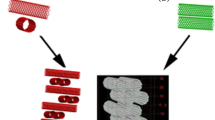Abstract
Since the anharmonicity of the vibrational mode related to the relative rigid motion of graphene layers plays a decisive role in the friction behavior of graphite, a quantitative account of the temperature dependence of the frequency of this \(E_{2{\rm g}}\)(1) mode is worth to be investigated. Starting with the solution of the Morse quantum-mechanical oscillator, a relationship between the populated averaged vibrational quantum number and temperature is proposed. This expression is applied to our previous computed Morse fittings describing the anharmonic potential of this mode (Menéndez et al. in Phys Rev B 93:144112-1–144112-9, 2016) with the aim at providing the available vibrational energy at different pressures and temperatures. We show that the average vibrational quantum number decreases under pressure but the available vibrational energy is almost independent on pressure at a given temperature. As a result, the calculated temperature coefficient shows that inter-layer friction in graphite lowers as temperature increases with a similar trend regardless the pressure applied.




Similar content being viewed by others
References
Errea I, Calandra M, Pickard CJ, Nelson JR, Needs RJ, Li Y, Liu H, Zhang Y, Ma Y, Maur F (2016) Nature 532:81
Lucazeu G (2003) J Raman Spectrosc 34:478
Mate CM, McClelland MG, Erlandsson CS (1987) Phys Rev Lett 59:1942
Tan PH, Han WP, Zhao WJ, Wu ZH, Chang K, Wang H, Wang FY, Bonini N, Marzari N, Pugno N, Savini G, Lombardo A, Ferrari AC (2012) Nat Mater 11:294
Menéndez C, Lobato A, Abbasi-Pérez D, Fernández-Núñez J, Baonza VG, Recio JM (2016) Phys Rev B 93:144112-1–144112-9
Hanfland M, Beister H, Syassen K (1989) Phys Rev B 39:12598
Koukaras EN, Kalosakas G, Galiotis C, Papagelis K (2015) Sci Rep 5:12923
Abbasi-Pérez D, Menéndez JM, Recio JM, Otero-de-la-Roza A, del Corro E, Taravillo M, Baonza VG, Marqués M (2014) Phys Rev B 90:054105
Kresse G, Furthmuller J (1996) Phys Rev B 54:11169
Perdew JP, Burke K, Ernzerhof M (1996) Phys Rev Lett 77:3865
Monkhorst HJ, Pack JD (1976) Phys Rev B 13:5188
Grimme S (2006) J Comput Chem 27:1787
Cohen-Tannoudji C, Diu B, Lalou F (1977) Quantum mechanics, vol 2, 1st edn. Wiley, London
Dahl JP, Springborg JM (1988) Chem Phys 88:4535
Kittel c (2004) Introduction to solid state physics, 8th edn. Wiley, London
Bonini N, Lazzeri M, Mauri F (2007) Phys Rev Lett 99:176802
Acknowledgements
Financial support from Principado de Asturias (GRUPIN14-049) and the Spanish MINECO project (CTQ2015-67755-C2-R and MAT2015-71070-REDC) are gratefully acknowledged.
Author information
Authors and Affiliations
Corresponding author
Additional information
Published as part of the special collection of articles derived from the 10th Congress on Electronic Structure: Principles and Applications (ESPA-2016).
Rights and permissions
About this article
Cite this article
Menéndez, C., Lobato, A., Baonza, V.G. et al. Temperature effects on the friction-like mode of graphite. Theor Chem Acc 136, 40 (2017). https://doi.org/10.1007/s00214-017-2072-4
Received:
Accepted:
Published:
DOI: https://doi.org/10.1007/s00214-017-2072-4




